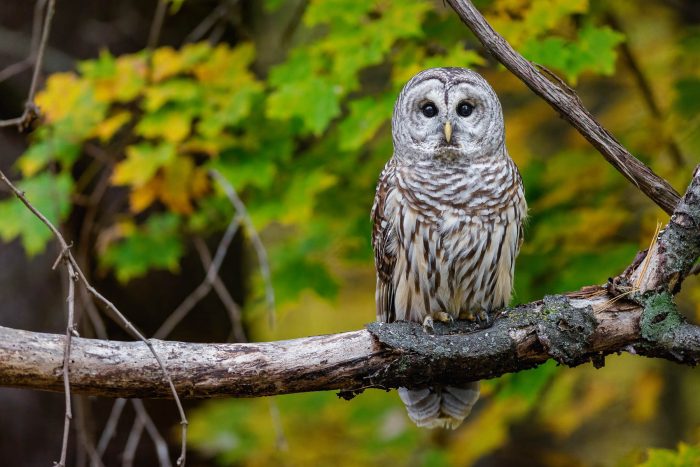Barred owl
Strix varia
Barred owls are large owls with round heads and a stout stature. They can be recognized by their "who-cooks-for-you, who-cooks-for-you-all" call. Barred owls and common barn owls are the only eastern owl species that have dark brown eyes.
This section shows one large critter image at a time. Use the thumbnails that follow to select a specific image to display here.

This gallery contains a grid of small thumbnails. Selecting a thumbnail will change the main image in the preceding section.
Appearance
The barred owl's large brown eyes contrast with its gray face and pale yellow beak. Males and females share the same mottled brown and white coloring. Bold brown streaks run vertically up the owl’s belly and horizontally across its breast, while its wings and tail are barred white and brown. Females are slightly larger than males.
Feeding
Barred owls hunt at night but occasionally feed during the day. They generally sit on an elevated perch to hunt, using their acute sense of sight and sound to hone in on prey, but will also hover over bodies of water or wade in the shallows in pursuit of fish and crayfish. They feed on small animals, including mice, squirrels, voles, rabbits, other birds, reptiles, insects and amphibians.
Predators
The barred owl has only one known natural predator: the great horned owl. Although these two species share a habitat, the barred owl will relocate to a different part of its territory whenever a great horned owl is nearby.
Flight
Its soft feathers are quiet, but not ideal for catching wind. So while these feathers help the barred owl sneak up on prey, they do not allow the owl to soar, and it must expend a great deal of energy to remain airborne.
Voice
Barred owls are recognized by their infamous call of “who-cooks-for-you, who-cooks-for-you-all,” which is comprised of eight or nine different notes.
Reproduction and life cycle
Barred owls are monogamous and mate for life, raising one brood each year. Breeding season runs from December through March. To attract a mate, males “display” by swaying back and forth, raising their wings and sliding along a branch. Calls are important during the barred owl mating ritual, as the bird performs various gurgles, cackles, hoots and caws.
Barred owls are cavity nesters who occupy holes in trees. Nest cavities are usually 10 to 13 inches wide and 14 to 21 inches deep, and are sometimes decorated with feathers, lichen or conifer sprigs. When humans or predators interfere with a nest, barred owls will create a distraction elsewhere by hooting, pretending to be injured or attacking. Females lay a clutch of two to three pure white, rough-surfaced eggs. Incubation lasts for 28 to 33 days. During incubation and after the chicks hatch, the male will hunt for and feed his mate and offspring. Young become sexually mature at two years of age and can live up to 32 years.
Did you know?
- Juvenile barred owls can climb trees by gripping the bark with their talons and bill while flapping their wings and walking up the trunk.
- Barred owls are the largest and most common owl found in bottomland woods and swamps.
Sources and additional information
- Chesapeake Bay: Nature of the Estuary, A Field Guide by Christopher P. White
- Barred Owl – The Cornell Lab of Ornithology
